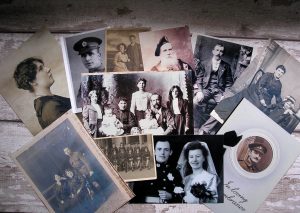You’ve been meaning to do it for some time. You’ve seen the TV programmes; perhaps you have a friend who’s done it, or perhaps you have an interest in history, and you’re interested in what your ancestors were doing during, for example, the industrial revolution. Now, perhaps, you’ve got a bit of time to make a start… but where do you start with tracing your ancestors? The TV ads make it look easy, but you suspect that may be just advertising hype (you’d be right); there are professional genealogists out there, but you’d rather have the fun of doing it yourself. But, how do you start? And where do you start – and, even, who do you start with?
I don’t recommend jumping straight into the online genealogy websites without some initial, important steps. The following steps will help to get you started, get clear about what and who you want to start with, and prepare the way for the serious, online research.
- Start with what you know and work backwards. Or, to answer the last question above first, start with yourself. The vast majority of us know when and where they were born, and who their parents were, so start with that.
- Decide on which line you’re going to follow first. With your parents, you have two ancestral lines, with your grandparents you have four lines – and this doubles for each generation you go back. So to keep things simple, you need to start with one line and focus on that until you can go no further, and then start on another. Most people start with the male line because it’s the same surname all the way back (although, there are exceptions to this).
- Find out if anyone in your family has already done any research. While it’s fun to do the research yourself, you don’t want to do work that’s already been done – though you might want to check they’ve done a good job anyway! You could then join them in the research, carry on where they’ve left off, or pick a line that has not been covered.
- Contact other members of your living family. Before you start any online searches, you need to find out whether there are any documents or photographs that might help, or even spark off an avenue of research. Older members of the family usually love talking about old times, and you can find out a lot about grandparents and great-grandparents that you never knew before – though treat any specific dates and places with a pinch of salt – memories can be inaccurate.

- Use old photographs to find out more. Following on from the last point, photographs make a great talking point, and it’s nice to have a face to pin information on before you start the real research. Occasionally, you’ll find photographs without any known name or date. Once you start researching, it can be fun to try and fit these into the puzzle.
- Draw up a chart. Before you start searching online, draw up a chart of what you already know. My post on charts will help with this. Doing this will give you a clear idea of gaps in your knowledge, and where to start when you begin the serious research.
- Decide on which software to use. Family tree software makes producing charts and notes much simpler than making lots of typed or handwritten notes. There are plenty on the market. The most popular is Family Tree Maker – but you can find more at MyHistory.com – and they also have other family history stationery and aids which you may find of use.
- Learn how to do the research. If you are completely new to tracing ancestors, there are several pitfalls you could fall into. To make sure you don’t make some common mistakes and end up following the wrong tree, invest in some books, or enrol on a course. My own beginner’s course takes you step-by-step through the process, and you can start your research as you go through the course. Learning how to research properly will introduce you to the most useful types of documents and how to get the most out of them.
- Start a free trial at Ancestry or FindMyPast. When you’ve got a lot of free time for a couple of weeks, take advantage of the two-week free trials available at both these websites. In time, it would be useful to subscribe to both, as some resources have better coverage on one over the other. Use the free trials to get to know your way around the websites, and use their search engines.
- Start with the known and work backwards. I know this is almost the same as the first tip – but it’s the most important mantra in genealogy. Now you’re starting the actual research, you need to keep to the same rule. Begin with the most recent available records, which may be civil registration and/or the 1939 Register. Find your known ancestors on these, and then work backwards to the census records and so on. For more details on researching these records, see my course, or read the appropriate books.
If you follow these initial steps you will be thoroughly prepared to start your searches and giving yourself the best chance of carrying out your research in a professional and efficient manner.

